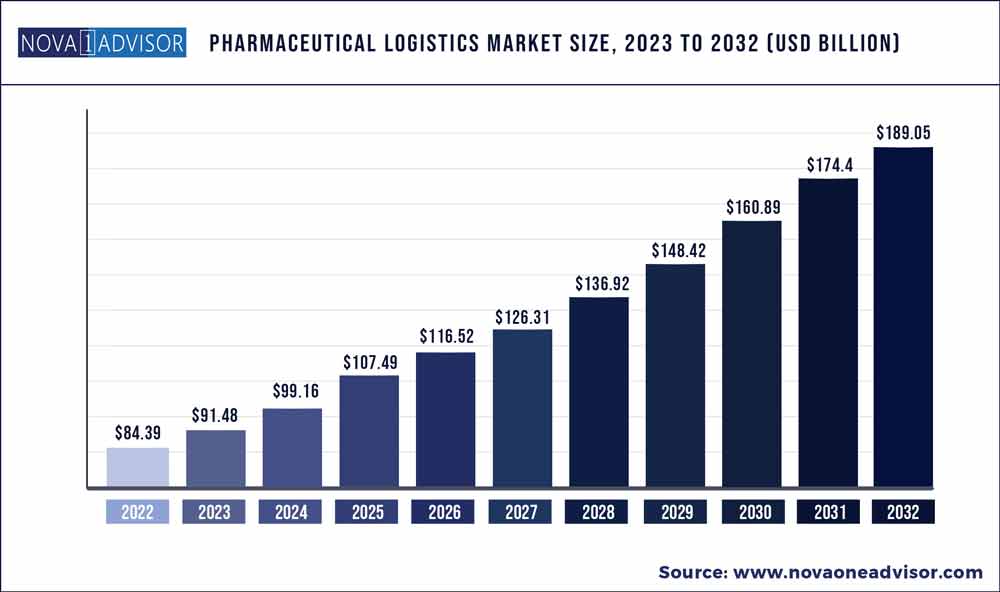The global pharmaceutical logistics market size was exhibited at USD 84.39 billion in 2022 and is projected to hit around USD 189.05 billion by 2032, growing at a CAGR of 8.4% during the forecast period 2023 to 2032.

Key Pointers:
- In terms of value, cold chain logistics segment is anticipated to hold a considerate market share by 2032 and is expected to grow at significant growth rate from 2023 to 2032.
- The storage segment attained the largest market share of more than 63.19% in 2022.
- The monitoring components segment is expected to witness the highest CAGR from 2023 to 2032
- Europe accounted for a market share of over 36.9% in 2022
- The Asia Pacific region is projected to be the fastest-growing region
Pharmaceutical Logistics Market Report Scope
|
Report Coverage
|
Details
|
|
Market Size in 2023
|
USD 91.48 Billion
|
|
Market Size by 2032
|
USD 189.05 Billion
|
|
Growth Rate From 2023 to 2032
|
CAGR of 8.4%
|
|
Base Year
|
2022
|
|
Forecast Period
|
2023 to 2032
|
|
Segments Covered
|
Type, Component, Application, Procedure
|
|
Market Analysis (Terms Used)
|
Value (US$ Million/Billion) or (Volume/Units)
|
|
Regional Scope
|
North America; Europe; Asia Pacific; Central and South America; the Middle East and Africa
|
|
Key Companies Profiled
|
FedEx, Agility, CEVA Logistics, Deutsche Post AG, VersaCold Logistics Services, LifeConEx, Air Canada, United Parcel Service of America Inc., DB Schenker, Marken.
|
The market growth is primarily driven by the rising demand for a variety of drugs as a result of increasing cases of chronic and lifestyle-related diseases. The market is expected to witness a high growth rate in cold-chain and non-cold chain pharmaceutical logistics owing to the impact of COVID-19 across the globe. During this pandemic situation, the government and officials across countries are primarily focusing on preventive measures and the treatment of patients. The import and export of various medicines to treat coronavirus are increasing across all countries, including U.S. and China.
Along with international trade, the nationwide logistics of drugs are also expected to increase to fulfill the rising demand from all the hospitals and medical establishments. Additionally, the U.S. Food and Drug Administration (FDA) and other healthcare agencies across various countries, such as India, China, and the U.K. approved the emergency use of COVID-19 vaccines. This, in turn, is expected to increase the global trade of vaccines in many countries, including the U.S. and India. Such increased trade of drugs and medicines across countries is expected to drive the market from 2023 to 2030.
Pharmaceutical logistics is an integral part of the healthcare system, as careful handling and transportation of pharmaceutical products are of utmost importance. Therefore, the equipment and staff services involved in the pharma supply chain are highly expensive. The latest trend gaining momentum in the market is consolidation among the pharma companies to expand their business and global presence. Technological advancements, such as cloud-based supply chain functions and blockchain technology, which provide accurate and real-time data of operations, will also have a positive impact on market growth. Additionally, these technologies also offer predictive analytics to identify demand and supply chain optimization and risk management. Identifying risks and preventing them helps companies increase productivity, efficiency, and process optimization of their businesses.
The market in Asia Pacific is projected to exhibit the highest CAGR from 2023 to 2032 owing to an increasing financial budget for the healthcare sector in several emerging countries of the region. Additionally, the soaring consumer spending in Over the Counter (OTC) pharmaceutical products is further boost the regional market growth over the forecast period.
Some of the prominent players in the Pharmaceutical Logistics Market include:
- FedEx
- Agility
- CEVA Logistics
- Deutsche Post AG
- VersaCold Logistics Services
- LifeConEx
- Air Canada
- United Parcel Service of America Inc.
- DB Schenker
- Marken
Segments Covered in the Report
This report forecasts revenue growth at global, regional, and country levels and provides an analysis of the latest industry trends in each of the sub-segments from 2018 to 2032. For this study, Nova one advisor, Inc. has segmented the global Pharmaceutical Logistics market.
By Type
- Cold Chain Logistics
- Non-cold Chain Logistics
By Component
- Storage
- Warehouse
- Refrigerated container
- Transportation
- Sea freight Logistics
- Airfreight Logistics
- Overland Logistics
- Monitoring components
- Hardware
- Sensors
- RFID Devices
- Telematics
- Networking Devices
- Software
By Application
- Bio Pharma
- Chemical Pharma
- Speciality Pharma
By Procedure
- Picking
- Storage
- Retrieval Systems
- Handling Systems
By Region
- North America
- Europe
- Asia-Pacific
- Latin America
- Middle East & Africa (MEA)

